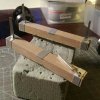American Locomotives - An Engineering History is the second edition, published in 1997, of White's earlier (1968 I think) A History of American Locomotives. I only have the 1997 version but it says in the preface that 92 pages and 45 new illustrations have been added, mostly previously unpublished drawings. The earlier book will be good, the later edition is better. White was employed by the Smithsonian so had good access to sources. His other books The American Railroad Passenger Car and The American Railroad Freight Car are also well worth acquiring for early US information.
Hi,
I agree with Overseer's recommendation for these three books.
Peter
Edit:
A History of the American Locomotive Its Development: 1830–1880 9780486238180 is the 1968 edition of American Locomotives: An Engineering History: 1830-1880 republished by Dover Publications Inc in 1979. It does not have the additional information of the 1997 edition.
Last edited:









